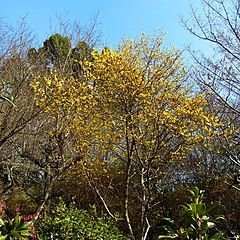| Chimonanthus praecox | |
|---|---|

| |
| Winter flowers on leafless stems | |
| Scientific classification | |
| Kingdom: | Plantae |
| Clade: | Tracheophytes |
| Clade: | Angiosperms |
| Clade: | Magnoliids |
| Order: | Laurales |
| Family: | Calycanthaceae |
| Genus: | Chimonanthus |
| Species: | C. praecox
|
| Binomial name | |
| Chimonanthus praecox | |
| Synonyms[1] | |
| |
Chimonanthus praecox, also known as wintersweet[1] and Japanese allspice,[2] is a species of flowering plant in the genus Chimonanthus of the family Calycanthaceae, native to China. The plant is known as làméi (蠟梅) in Chinese. The plant is also grown in Iran, where it is called gol-e yakh (گلیخ) or "ice flower" in Persian.[3]
It is a vigorous deciduous shrub growing to 4 m (13 ft) tall with an erect trunk and leaves 5–29 cm (2–11 in) long and 2–12 cm (1–5 in) broad. Its strongly scented pendent flowers, produced in winter (between November and March in UK,[4]) on bare stems, have 15-21 yellow or pale green-yellow, tepals, the inner ones usually with purplish red pigments.[5][2][6]
-
A&B: flowers; C: foliage; D: hypanthium; E: longitudinal section of hypanthium; F: fruit; G: terminal leaf buds; H: seedling
-
Winter flowering
-
Leaves and fruit
This plant is cultivated in gardens, producing valued flower colour in the dormant season. The cultivars C. praecox 'Grandiflorus'[7] and C. praecox 'Luteus'[8] have gained the Royal Horticultural Society's Award of Garden Merit.
The plant is not closely related to allspice, Pimenta dioica.
- ^ a b "Chimonanthus praecox (L.) Link". Plants of the World Online. Royal Botanic Gardens, Kew. Retrieved 2021-02-12.
- ^ a b "Chimonanthus praecox". Germplasm Resources Information Network. Agricultural Research Service, United States Department of Agriculture. Retrieved 2008-06-02.
- ^ "راهنمای نگهداری و پرورش گل و گیاهان زینتی - گل یخ". نارگیل. 2012-07-01. Retrieved 2024-03-11.
- ^ Nicholson, B.E.; Wallis, Michael (1963). The Oxford Book of Garden Flowers. London: Oxford University Press. p. viii. ISBN 978-0199100026.
- ^ "eFloras - Flora of China - Chimonanthus praecox". Efloras.org. Retrieved 5 July 2013.
- ^ RHS A-Z encyclopedia of garden plants. United Kingdom: Dorling Kindersley. 2008. p. 1136. ISBN 978-1405332965.
- ^ "RHS Plant Selector - Chimonanthus praecox 'Grandiflorus'". Retrieved 15 April 2020.
- ^ "RHS Plant Selector - Chimonanthus praecox 'Luteus'". Retrieved 15 April 2020.


